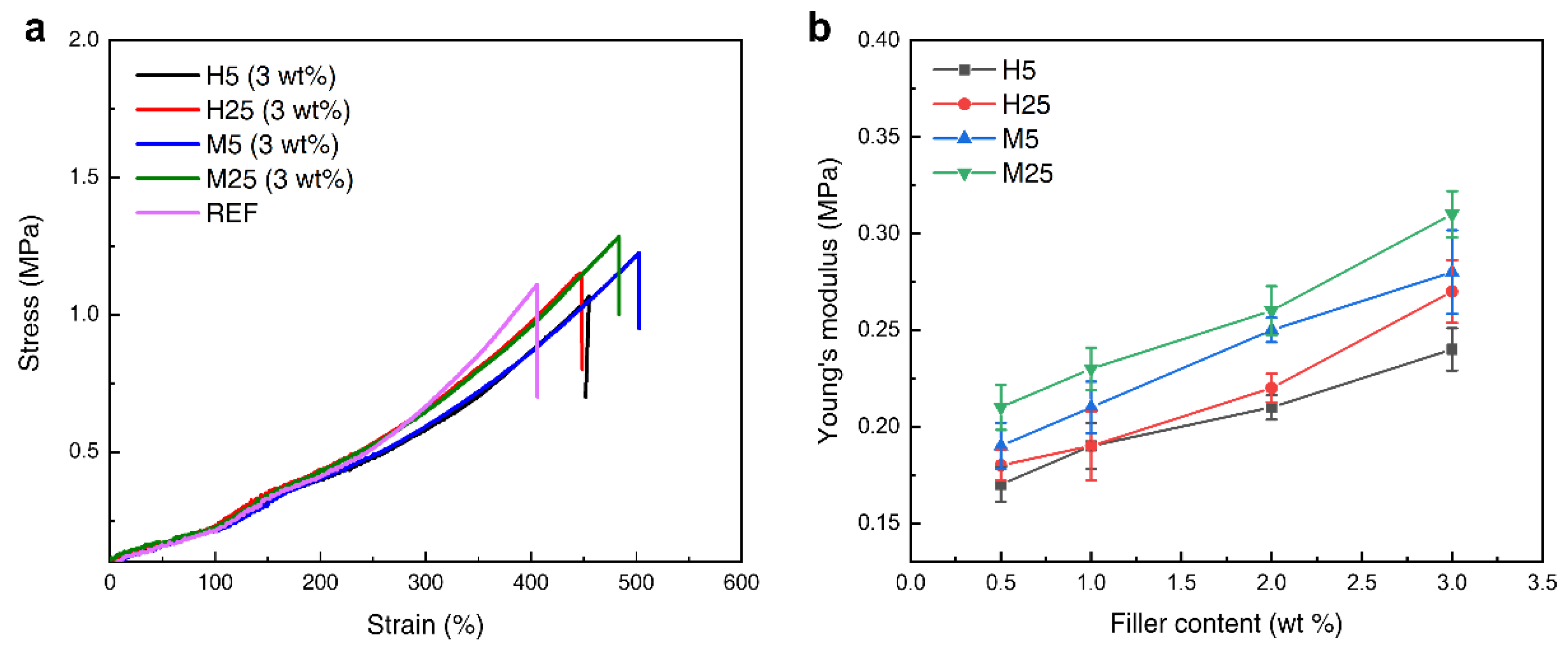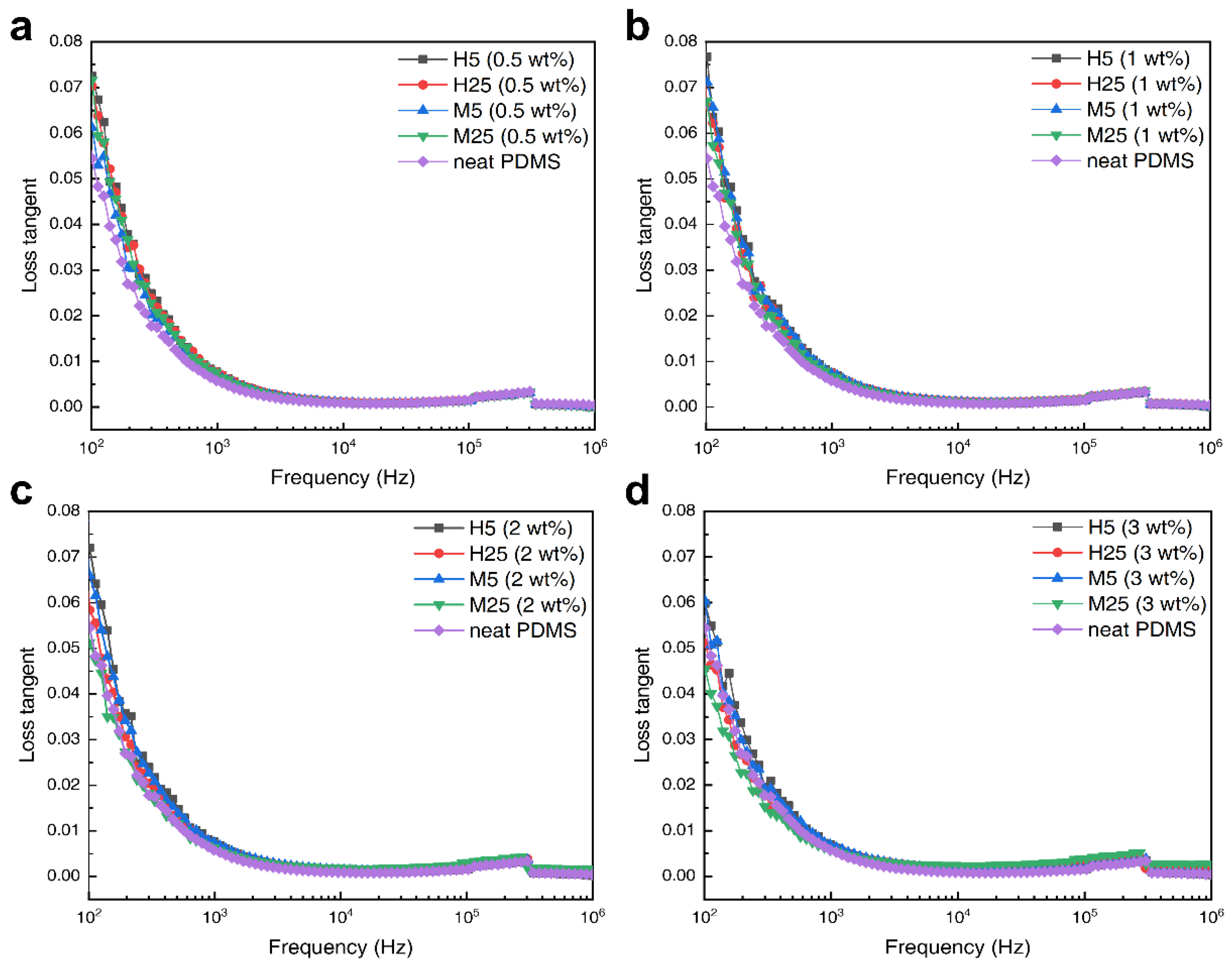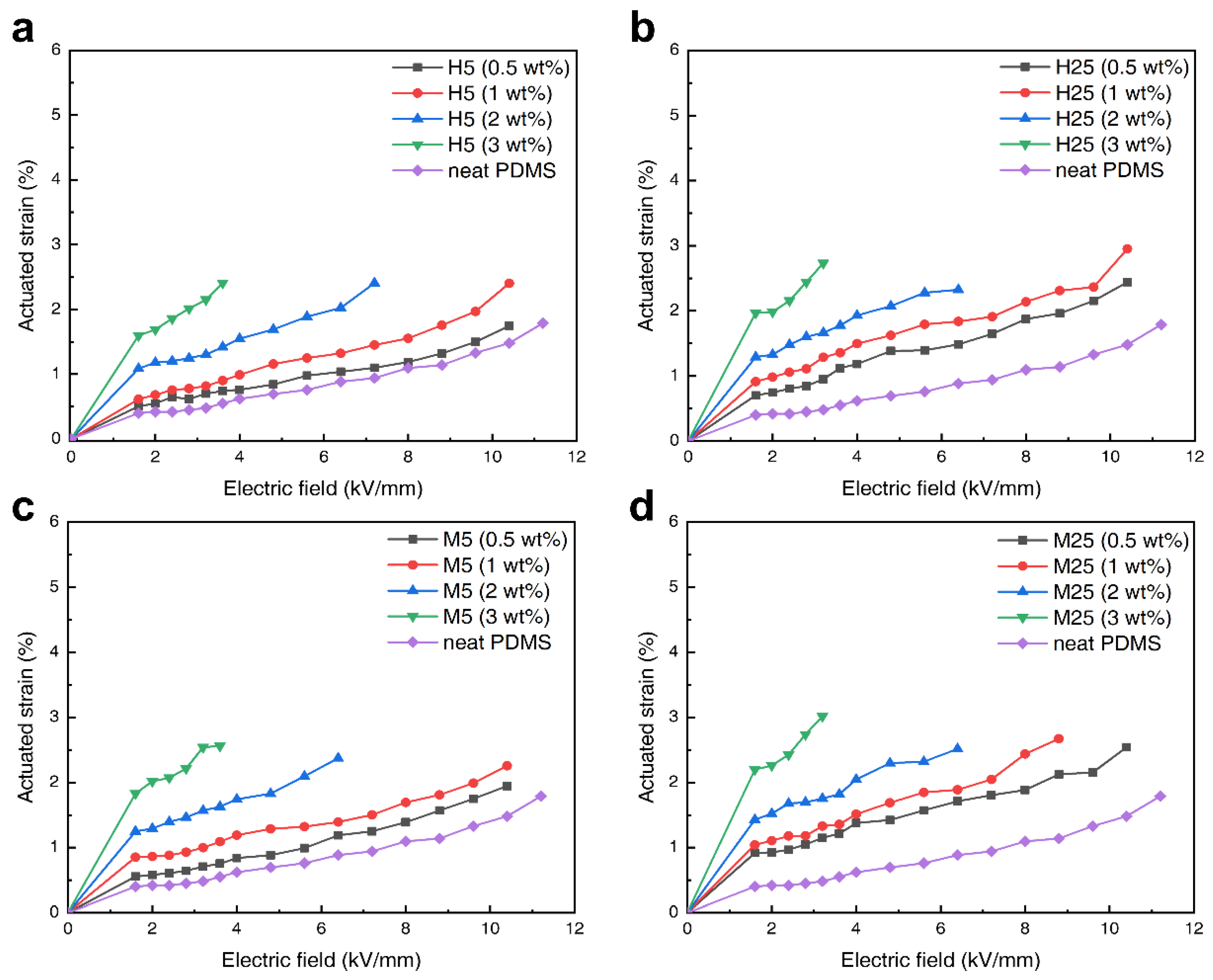Effect of the Particle Size and Layer Thickness of GNP Fillers on the Dielectric Properties and Actuated Strain of GNP–PDMS Composites
Abstract
:1. Introduction
2. Materials and Methods
2.1. Materials
2.2. Method
2.2.1. Fabrication of GNP–PDMS Composite
2.2.2. Characterization
3. Results and Discussion
3.1. Morphology and Characterization of GNPs
3.2. Mechanical Properties of GNP–PDMS Composites
3.3. Electromechanical Properties of GNP–PDMS Composites
4. Conclusions
Supplementary Materials
Author Contributions
Funding
Institutional Review Board Statement
Informed Consent Statement
Data Availability Statement
Conflicts of Interest
References
- Shahrzad, J.M.; Alireza, M.; Carlo, M.; Rodney, G.V. A review of mechanically reconfigurable antennas using smart material actuators. In Proceedings of the 5th European Conference on Antennas and Propagation (EUCAP), Rome, Italy, 11–15 April 2011; pp. 1076–1079. [Google Scholar]
- Chad, B.; Justin, D.; Andrew, G.; Mark, K. Review of Smart Material Based Actuators for Artificial Muscles. Ph.D. Thesis, University of Toronto, Toronto, ON, Canada, 2007; pp. 1–85. [Google Scholar]
- Sun, j.; Guan, Q.; Liu, Y.; Leng, J. Morphing aircraft based on smart materials and structures: A state-of-the-art review. J. Intel. Mater. Syst. Struct. 2016, 27, 2289–2312. [Google Scholar] [CrossRef]
- Ning, C.; Zhou, Z.; Tan, G.; Zhu, Y.; Mao, C. Electroactive polymers for tissue regeneration: Developments and perspectives. Prog. Polym. Sci. 2018, 81, 144–162. [Google Scholar] [CrossRef] [PubMed]
- Damilola, R.; Tania, B.; Jennifer, A.I. Biomedical application of electroactive polymers in electrochemical sensors: A review. Materials 2019, 12, 2629. [Google Scholar]
- Cohen, Y.B.; Anderson, I.A. Electroactive polymer (EAP) actuators—Background review. Soft Mater. 2019, 1, 1–14. [Google Scholar]
- Alsksey, V.M.; Tarek, D.; Dmitry, V.T.; Alexander, Y.G. Electroactive polymer-based composites for artificial muscle-like actuators: A review. J. Nanomater. 2022, 12, 2272. [Google Scholar]
- Asaka, K.; Mukai, K.; Sugino, T.; Kiyohara, K. Ionic electroactive polymer actuators based on nano-carbon electrodes. Science 2013, 62, 1263–1270. [Google Scholar] [CrossRef]
- Palakodeti, R.; Kessler, M.R. Influence of frequency and prestrain on the mechanical efficiency of dielectric electroactive polymer actuators. Mater. Lett. 2006, 60, 3437–3440. [Google Scholar] [CrossRef]
- Alici, G.; Geoffrey, M.; Spinks, J.D.; Madden, J.D.; Yanzhe, W.; Gordon, G. Response characterization of electroactive polymers as mechanical sensors. IEEE ASME Trans. Mechatron. 2008, 13, 2. [Google Scholar] [CrossRef]
- Adelyne, F.; Rauno, T.; Giao, T.M.N.; Laurent, C.; Elisabeth, L.; John, D.W.M.; Frederic, V.; Cedric, P. Linear artificial muscle based on ionic electroactive polymer: A rational design for open-air and vacuum actuation. Adv. Mater. Technol. 2018, 4, 1800519. [Google Scholar]
- Xu, H.; Han, C.; Liu, X.; Li, J.; Sun, Z. A highly flexible and stretchable ionic artificial muscle. Sens. Actuators A Phys. 2021, 332, 113190. [Google Scholar] [CrossRef]
- Liu, X.; Xu, H.; Li, Y.; Jing, M.; Wang, W.; Li, Z.; Zhang, P.; Sun, Z. A stretchable and self-healing ionic artificial muscle modified by conductive substances. Appl. Phys. 2022, 118, 116. [Google Scholar] [CrossRef]
- Chang, L.; Liu, Y.; Yang, Q.; Yu, L.; Liu, J.; Zhu, Z.; Lu, P.; Wu, Y.; Hu, Y. Ionic electroactive polymers used in bionic robots: A review. J. Bionic Eng. 2018, 15, 764–782. [Google Scholar] [CrossRef]
- Mun, S.C.; Yun, S.R.; Nam, S.W.; Park, S.K.; Park, S.T.; Park, B.J.; Lim, J.M.; Kyung, K.U. Electro-active polymer based soft tactile interface for wearable devices. IEEE Trans. Haptics. 2018, 11, 1. [Google Scholar] [CrossRef] [PubMed]
- Qiu, Y.; Lu, Z.; Pei, Q. Refreshable tactile display based on a bistable electroactive polymer and a stretchable serpentine joule heating electrode. ACS Appl. Mater. 2018, 10, 24807–24815. [Google Scholar] [CrossRef] [PubMed]
- Gupta, U.; Qin, L.; Wang, Y.; Godaba, H.; Zhu, J. Soft robots based on dielectric elastomer actuators: A review. Smart Mater. Struct. 2019, 28, 103002. [Google Scholar] [CrossRef]
- Hajiesmaili, E.; Clarke, D.R. Dielectric elastomer actuators. J. Appl. Phys. 2021, 129, 151102. [Google Scholar] [CrossRef]
- Qiu, Y.; Zhang, E.; Plamthottam, R.; Pei, Q. Dielectric elastomer artificial muscle: Materials innovations and device explorations. Acc. Chem. 2019, 52, 316–325. [Google Scholar] [CrossRef]
- Ji, X.; Haitami, A.E.; Sorba, F.; Rosset, S.; Nguyen, G.T.M.; Plesse, C.; Vidal, F.; Shea, H.R.; Cantin, S. Stretchable composite monolayer electrodes for low voltage dielectric elastomer actuators. Sens. Actuators B Chem. 2018, 261, 135–143. [Google Scholar] [CrossRef]
- Youn, J.H.; Jeong, S.M.; Hwang, H.W.; Kim, H.W.; Hyeon, K.J.; Park, J.W.; Kyung, K.U. Dielectric elastomer actuator for soft robotics applications and challenges. Appl. Sci. 2020, 10, 640. [Google Scholar] [CrossRef]
- Ghosh, S.; Inganäs, O. Networks of electron-conducting polymer in matrices of ion-conducting polymers applications to fast electrodes. Electrochem. Solid-State Lett. 2000, 3, 213–215. [Google Scholar] [CrossRef]
- Kaneto, K. Research trends of soft actuators based on electroactive polymers and conducting polymers. J. Phys. Conf. Ser. 2016, 704, 012004. [Google Scholar] [CrossRef]
- Wallmersperger, T.; Kröplin, B.; Holdenried, J.; Gulch, R.W. A coupled multi-field-formulation for ionic polymer gels in electric. In Proceedings of the Fifth World Congress on Computational Mechanics (WCCM V), Vienna, Austria, 7–12 July 2002. [Google Scholar]
- Bae, J.H.; Chang, S.H. PVDF-based ferroelectric polymers and dielectric elastomers for sensor and actuator applications: A review. Funct. Compos. Struct. 2019, 1, 012003. [Google Scholar] [CrossRef]
- Sikulskyi, S.; Mekonnen, D.T.; Atrache, A.E.; Divo, E.; Kim, D.W. Effects of ferroelectric fillers on composite dielectric elastomer actuator. Actuators 2021, 10, 137. [Google Scholar] [CrossRef]
- Qiao, B.; Wang, X.; Tan, S.; Zhu, W.; Zhang, Z. Synergistic effects of maxwell stress and electrostriction in electromechanical properties of Poly(vinylidene fluoride)-based ferroelectric polymers. Macromolecules 2019, 52, 9000–9011. [Google Scholar] [CrossRef]
- Choi, S.T.; Kwon, J.O.; Bauer, F. Multilayered relaxor ferroelectric polymer actuators for low-voltage operation fabricated with an adhesion-mediated film transfer technique. Sens. Actuators A Phys. 2013, 203, 282–290. [Google Scholar] [CrossRef]
- Kularatne, R.S.; Kim, H.; Boothby, J.M.; Ware, T.H. Liquid crystal elastomer actuators: Synthesis, alignment, and applications. J. Polym. Sci. B Polym. Phys. 2017, 55, 395–411. [Google Scholar] [CrossRef]
- Petsch, S.; Rix, R.; Khatri, B.; Schuhladen, S.; Müller, P.; Zentel, R.; Zappe, H. Smart artificial muscle actuators: Liquid crystal elastomers with integrated temperature feedback. Sens. Actuators A Phys. 2015, 231, 44–51. [Google Scholar] [CrossRef]
- Rosset, S.; Shea, H.R. Flexible and stretchable electrodes for dielectric elastomer actuators. Appl. Phys. A. 2013, 110, 281–307. [Google Scholar] [CrossRef]
- Lau, G.K.; Goh, S.C.K.; Shiau, L.L. Dielectric elastomer unimorph using flexible electrodes of Electrolessly Deposited (ELD) silver. Sens. Actuators A Phys. 2011, 169, 234–241. [Google Scholar] [CrossRef]
- Lee, Y.R.; Kwon, H.H.; Lee, D.H.; Lee, B.Y. Highly flexible and transparent dielectric elastomer actuators using silver nanowire and carbon nanotube hybrid electrodes. Soft Mater. 2017, 13, 6390–6395. [Google Scholar] [CrossRef]
- Shigemune, H.; Sugano, S.; Nishitani, J.; Yamauchi, M.; Hosoya, N.; Hashimoto, S.; Maeda, S. Dielectric elastomer actuators with carbon nanotube electrodes painted with a soft brush. Actuators 2018, 7, 51. [Google Scholar] [CrossRef]
- Sahu, R.K.; Saini, A.; Ahmad, D.; Patra, K.; Szpunar, J. Estimation and validation of maxwell stress of planar dielectric elastomer actuators. J. Mech. Sci. Technol. 2016, 30, 429–436. [Google Scholar] [CrossRef]
- Cameron, C.G.; Underhill, R.S.; Rawji, M.; Jeffrey, P. Conductive filler–elastomer composites for Maxwell stress actuator applications. Smart Mater. Struct. 2004, 5385, 0277–0786X. [Google Scholar]
- Boldini, A.; Porfiri, M. On Maxwell stress and its relationship with the dielectric constant in the actuation of ionic polymer metal composites. J. Mech. Phys. 2022, 164, 104875. [Google Scholar] [CrossRef]
- Zhao, H.; Zhang, L.; Yang, M.H.; Dang, Z.M.; Bai, J. Temperature-dependent electro-mechanical actuation sensitivity in stiffness-tunable BaTiO3/polydimethylsiloxane dielectric elastomer nanocomposites. Appl. Phys. Lett. 2015, 106, 092904. [Google Scholar] [CrossRef]
- Kim, I.J.; Kim, D.H.; Ahn, B.K.; Lee, H.J.; Kim, H.J.; Kim, W.H. Vulcanizate structures of NR compounds with silica and carbon black binary filler systems at different curing temperatures. Elastom. Compos. 2021, 56, 20–31. [Google Scholar]
- Han, S.W.; Kim, D.H.; Kim, S.R.; Kim, J.M.; Mun, D.Y.; Morita, K.; Kim, W.H. Effect of silane and sulfur variation on the vulcanizate structure of silica-filled styrene-butadiene rubber compounds. Elastom. Compos. 2021, 56, 32–34. [Google Scholar]
- Lee, M.J.; Park, S.H.; Jhee, K.H.; Kye, H.S.; Bang, D.S. Electrical properties of CNT and carbon fiber filled hybrid composites based on PA66. Elastom. Compos. 2021, 56, 65–71. [Google Scholar]
- Duan, L.; Wang, G.L.; Zhang, Y.Y.; Zhang, Y.N.; Wei, Y.Y.; Wang, Z.F.; Zhang, M. High dielectric and actuated properties of silicone dielectric elastomers filled with magnesium-doped calcium copper titanate particles. Polym. Compos. 2018, 39, 691–697. [Google Scholar] [CrossRef]
- Yang, D.; Zhang, L.; Ning, N.; Li, D.; Wang, Z.; Nishi, T.; Ito, K.; Tian, M. Large increase in actuated strain of HNBR dielectric elastomer by controlling molecular interaction and dielectric filler network. RSC Adv. 2013, 3, 21896–21904. [Google Scholar] [CrossRef]
- Chen, T.; Pan, L.; Lin, M.; Wang, B.; Liu, L.; Li, Y.; Qiu, J.; Zhu, K. Dielectric, mechanical and electro-stimulus response properties studies of polyurethane dielectric elastomer modified by carbon nanotube-graphene nanosheet hybrid fillers. Polym Test. 2015, 47, 4–11. [Google Scholar] [CrossRef]
- Chen, T.; Qiu, J.; Zhu, K.; Li, J.; Wang, J.; Li, S.; Wang, X. Achieving high performance electric field induced strain: A rational design of hyperbranched aromatic polyamide functionalized graphene−polyurethane dielectric elastomer composites. J. Phys. Chem. B. 2015, 119, 4521–4530. [Google Scholar] [CrossRef] [PubMed]
- Karolina, G.; Xiangdong, X.; Stanislaw, G.; Roland, K. Electrical, mechanical, and thermal properties of LDPE graphene nanoplatelets composites produced by means of melt extrusion process. Polymer 2017, 9, 11. [Google Scholar]
- Amutha, S.A.J.; Lndhumathi, K.; Arun Prakash, V.R. Role of cobalt nanowire and graphene nanoplatelet on microwave shielding behavior of natural rubber composite in high frequency bands. Polymer Compos. 2020, 41, 4362–4371. [Google Scholar] [CrossRef]
- Yaguang, G.; Liwu, L.; Yanju, L.; Jinsong, L. Review of dielectric elastomer actuators and their applications in soft robots. Adv. Intell. Syst. Comput. 2021, 3, 2000282. [Google Scholar]








| Sample Label | Tensile Strength (σ) | Elongation at Break (%) | Young’s Modulus (Y) | Dielectric Constant at 1 kHz | Loss Tangent at 1 kHz (δ) | Electromechanical Sensitivity |
|---|---|---|---|---|---|---|
| Neat PDMS | 1.108 | 406.1 | 0.18 | 2.15 | 0.0053 | 11.9 |
| H5 (3 wt%) | 1.067 | 451.8 | 0.24 | 2.9 | 0.0062 | 12.08 |
| H25 (3 wt%) | 1.151 | 448.65 | 0.27 | 3.82 | 0.0061 | 14.14 |
| M5 (3 wt%) | 1.225 | 502.8 | 0.28 | 3.42 | 0.0059 | 12.21 |
| M25 (3 wt%) | 1.301 | 483.65 | 0.31 | 4.26 | 0.0054 | 13.74 |
Publisher’s Note: MDPI stays neutral with regard to jurisdictional claims in published maps and institutional affiliations. |
© 2022 by the authors. Licensee MDPI, Basel, Switzerland. This article is an open access article distributed under the terms and conditions of the Creative Commons Attribution (CC BY) license (https://creativecommons.org/licenses/by/4.0/).
Share and Cite
Seo, J.-S.; Kim, D.-H.; Jung, H.-S.; Kim, H.-D.; Choi, J.; Kim, M.; Baeck, S.-H.; Shim, S.-E. Effect of the Particle Size and Layer Thickness of GNP Fillers on the Dielectric Properties and Actuated Strain of GNP–PDMS Composites. Polymers 2022, 14, 3824. https://doi.org/10.3390/polym14183824
Seo J-S, Kim D-H, Jung H-S, Kim H-D, Choi J, Kim M, Baeck S-H, Shim S-E. Effect of the Particle Size and Layer Thickness of GNP Fillers on the Dielectric Properties and Actuated Strain of GNP–PDMS Composites. Polymers. 2022; 14(18):3824. https://doi.org/10.3390/polym14183824
Chicago/Turabian StyleSeo, Jin-Sung, Do-Hyeon Kim, Heon-Seob Jung, Ho-Dong Kim, Jaewon Choi, Minjae Kim, Sung-Hyeon Baeck, and Sang-Eun Shim. 2022. "Effect of the Particle Size and Layer Thickness of GNP Fillers on the Dielectric Properties and Actuated Strain of GNP–PDMS Composites" Polymers 14, no. 18: 3824. https://doi.org/10.3390/polym14183824
APA StyleSeo, J.-S., Kim, D.-H., Jung, H.-S., Kim, H.-D., Choi, J., Kim, M., Baeck, S.-H., & Shim, S.-E. (2022). Effect of the Particle Size and Layer Thickness of GNP Fillers on the Dielectric Properties and Actuated Strain of GNP–PDMS Composites. Polymers, 14(18), 3824. https://doi.org/10.3390/polym14183824







